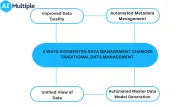Data

Data Pipeline: Types & Benefits in 2024
Businesses generate or move huge amounts of data from multiple sources and systems. However, preparing the data for analysis and gaining actionable business insights is not easy as the data needs to be combined in a meaningful way.

4 Metadata Management Best Practices in 2024 (Top Tools)
As the volume of data increases, the data environment becomes more complex. It can become increasingly difficult for organizations to prepare and store data, make it available to users, and set rules for incoming data. These data management challenges limit the use of and prevent getting the most from organizational data.

Data Orchestration to Get the Most from Your Data in 2024
Gaining valuable insights from business data requires high-level analytical capabilities and successful data management is critical to improving an organization’s analytical skills. Data orchestration automates data management processes by automatically ingesting data from multiple sources, merging it into a central repository, preparing it, and making available data to all internal tools.

Top 6 DataOps Tools in 2024: In-Depth Guide
Most data-driven companies struggle with data quality issues. High volumes of data, changing data storage requirements as a result of company policies and government regulations, and various types of data sources and formats make data management difficult for companies. DataOps tools automate and simplify all data life cycle phases.

Top 3 Applications of Entity Linking in 2024
Unstructured data such as videos, word documents or pdf files, images, and audio constitute a big portion of enterprise data. However, it is difficult to work with unstructured data and gain insights from it. Most AI and ML algorithms consume structured training data during model building.

Named Entity Recognition (NER): What It Is & How It Is Used in '24
By 2025, the global natural language processing (NLP) market is anticipated to be worth ~$43 billion, 14 times larger than it was in 2017 (Figure 1). NLP has a wide range of use cases in every industry from chatbots to document processing by enabling machines to understand and process human languages.

In-depth Guide to Semantic Segmentation in 2024
Computer vision enables computers to derive meanings from images and videos and enables companies to conduct complex tasks such as image classification, restoration, and object detection. Semantic segmentation is a method used in computer vision applications that helps computers to understand what objects are present in an image.

Everything You Need to Know About DataOps in 2024
The necessity to store and process high volumes of data to gain insights are complicating data management in organizations. According to a survey by McKinsey, companies spend 80% of their time in analytics projects on tasks such as data preparation.

Understanding Data Mesh: The key features & principles in '24
Data environments and data sources are constantly changing. New data is generated in every business activity and there is a need to: It is important and necessary to adopt data-oriented approaches, analyze data networks and use them for operational activities. Data lakes and data warehouses are both used for storing large amounts of data.

Top Use Cases of Augmented Data Management in 2024
As the volume and the variety of data increases, data management becomes more complicated and time-consuming for businesses. Data ingestion and preparation are also becoming more labor-intensive, reducing overall efficiency and productivity. Traditional data management can be inefficient to address these challenges. Augmented data management can provide a solution to changing requirements of data management.